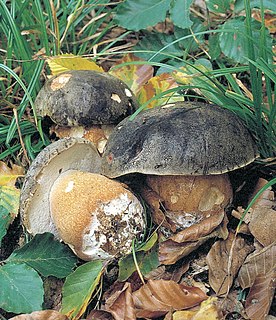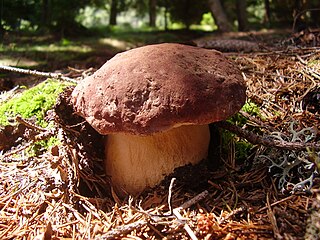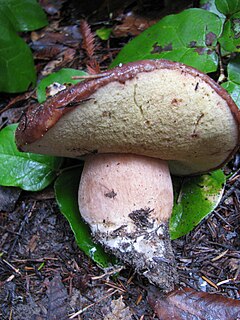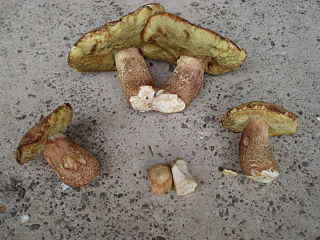
Boletus edulis is a basidiomycete fungus, and the type species of the genus Boletus. Widely distributed in the Northern Hemisphere across Europe, Asia, and North America, it does not occur naturally in the Southern Hemisphere, although it has been introduced to southern Africa, Australia, New Zealand, and Brazil. Several closely related European mushrooms formerly thought to be varieties or forms of B. edulis have been shown using molecular phylogenetic analysis to be distinct species, and others previously classed as separate species are conspecific with this species. The western North American species commonly known as the California king bolete is a large, darker-coloured variant first formally identified in 2007.

Boletus is a genus of mushroom-producing fungi, comprising over 100 species. The genus Boletus was originally broadly defined and described by Carl Linnaeus in 1753, essentially containing all fungi with hymenial pores instead of gills. Since then, other genera have been defined gradually, such as Tylopilus by Petter Adolf Karsten in 1881, and old names such as Leccinum have been resurrected or redefined. Some mushrooms listed in older books as members of the genus have now been placed in separate genera. These include such as Boletus scaber, now Leccinum scabrum, Tylopilus felleus, Chalciporus piperatus and Suillus luteus. Most boletes have been found to be ectomycorrhizal fungi, which mean that they form a mutualistic relationship with the roots system of certain kinds of plants. More recently, Boletus has been found to be massively polyphyletic, with only a small percentage of the over 300 species that have been assigned to Boletus actually belonging there and necessitating the description and resurrection of many more genera.

Boletus aereus, the dark cep or bronze bolete, is a highly prized and much sought-after edible mushroom in the family Boletaceae. The bolete is widely consumed in Spain, France, Italy, Greece, and generally throughout the Mediterranean. Described in 1789 by French mycologist Pierre Bulliard, it is closely related to several other European boletes, including B. reticulatus, B. pinophilus, and the popular B. edulis. Some populations in North Africa have in the past been classified as a separate species, B. mamorensis, but have been shown to be phylogenetically conspecific to B. aereus and this taxon is now regarded as a synonym.

Boletus reticulatus, and commonly referred to as the summer cep is a basidiomycete fungus of the genus Boletus. It occurs in deciduous forests of Europe where it forms a symbiotic mycorrhizal relationship with species of oak (Quercus). The fungus produces fruiting bodies in the summer months which are edible and popularly collected. The summer cep was formally described by Jacob Christian Schäffer as Boletus reticulatus in 1774, which took precedence over B. aestivalis as described by Jean-Jacques Paulet in 1793.

David Arora is an American mycologist, naturalist, and writer. He is the author of two popular books on mushroom identification, Mushrooms Demystified and All That the Rain Promises and More....

Boletus pinophilus, commonly known as the pine bolete or pinewood king bolete, is a basidiomycete fungus of the genus Boletus found throughout Europe and western Asia. described by Italian naturalist Carlo Vittadini in 1835, Boletus pinophilus was for many years considered a subspecies or form of the porcini mushroom B. edulis before genetic studies confirmed its distinct status. In 2008, B. pinophilus in western North America were reclassified as a new species, Boletus rex-veris. Boletus pinophilus is edible, and may be preserved and cooked.

Boletus rex-veris, commonly known as the spring king bolete, is a basidiomycete fungus of the genus Boletus found in western North America. The large, edible fruiting bodies known as mushrooms appear under pine trees, generally in May to June. It has a pinkish to brownish cap and its stem is often large and swollen, and the overall colour may have an orange-red tinge. As with other boletes, the size of the fruiting body is variable. Boletus rex-veris is edible, and may be preserved and cooked.

Boletus regineus, commonly known as the queen bolete, is an edible and highly regarded fungus of the genus Boletus that inhabits southwestern North America. It was considered a variant of the similarly edible B. edulis for many years until declared a unique species in 2008. Phylogenetic analysis has shown B. regineus as a member of a clade, or closely related group, with B. subcaerulescens, Gastroboletus subalpinus, B. pinophilus, B. fibrillosus, and B. rex-veris.

Boletus fibrillosus is a basidiomycete fungus of the genus Boletus found in western North America. The fruiting bodies are found in mixed coastal forests in the fall. The cap is up to 17 cm wide, buff to brown to dark brown in color, and has a wrinkled to finely fibrous texture. The tubes are yellow, while the flesh is white to buff and does not stain when cut. The stem is yellow at the top, brown otherwise, and has a reticulate texture. The holotype was collected in Mendocino County, California. Boletus fibrillosus is edible, but considered to have inferior taste to other edible boletes such as boletus edulis.

Boletus subcaerulescens is a basidiomycete fungus of the genus Boletus found in northeastern North America. The fruiting bodies are found associated with pine and spruce. The cap is up to 18 cm wide, convex to flat, and brown in color. The tubes are yellow and stain blue when bruised, while the flesh is white to buff and does not stain when cut. The stem is brown like the cap and has a light-colored reticulate texture.
Boletus albobrunnescens is a species of bolete fungus in the family Boletaceae. It is classified in the section Boletus of the genus Boletus, commonly known as the porcini mushrooms. First reported to science in 2010, the species was officially described in 2014. It is found in mixed evergreen and deciduous forests of Thailand, where it fruits singly to scattered in soil under Pinus and Castanopsis trees. Its fruit bodies have caps measuring 5.5–11 cm (2.2–4.3 in) in diameter. They are white but stain brown to reddish brown, hence the epithet, which combines the Latin words for "white" (albo) and "becoming brown" (brunnescens). The stipe measures 6–11 cm (2.4–4.3 in) long by 1.5–2 cm (0.6–0.8 in) thick except for the swollen base, which is up to 5 cm (2 in) in diameter. The top of the stipe has a prominent network pattern (reticulations) that diminishes as it extends down to over half its length. Like the cap, it also stains brown after handling. The smooth spores are roughly spindle-shaped (fusoid), and measure 10.5–11.9 by 4.2–4.9 μm.
Boletus mamorensis is an edible fungus of the genus Boletus native to Morocco. It is closely related to B. aereus.
Boletus pseudopinophilus is a species of porcini-like fungus native to eastern North America, where it grows under Pinus elliottii and Pinus palustris. Previously regarded as Boletus pinophilus it was found to have diverged significantly from the latter species.
Boletus quercophilus is a species of porcini-like fungus native to Costa Rica, where it grows under Quercus copeyensis and Quercus seemannii.
Boletus viscidiceps is a species of porcini-like fungus native to Yunnan Province in southwestern China.
Boletus bainiugan is a species of porcini-like fungus native to Henan, Sichuan and Yunnan Provinces in Central and Southwestern China, where it grows under Pinus yunnanensis, Pinus kesiya and Castanea mollissima.
Boletus botryoides is a species of porcini-like fungus native to Hunan Sichuan and Yunnan Provinces in Central China, where it grows under trees of the family Fagaceae.
Boletus orientialbus is a species of porcini-like fungus native to Fujian Province in Southeastern China, where it grows under trees of the genera Lithocarpus and Castanopsis in subtropical climates.
Boletus monilifer is a species of porcini-like fungus native to Yunnan Province in Southwestern China, where it grows under trees of the genera Lithocarpus, Quercus and Castanopsis in subtropical montane forests.









